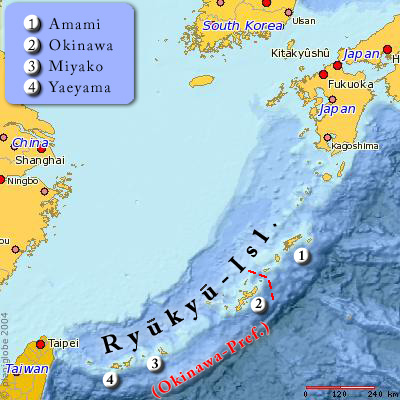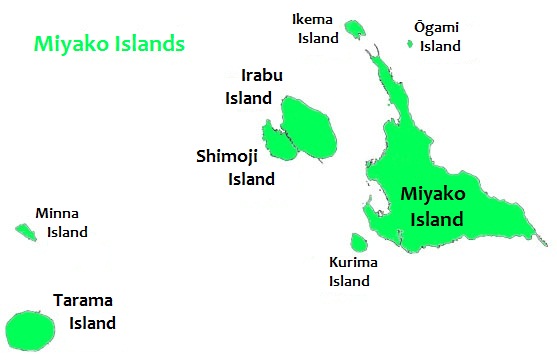|
Ōgami Island
Ōgami Island (大神島, ''Ōgami-jima)'', Ōgami dialect: ''Ukam'', is one of the islands of the Miyako Islands. It is about 4km north of Miyako-jima (island) and belongs to Miyakojima City, which was created in 2005 by a merger of many smaller towns on the island chain. Before the merger, it belonged to Hirara City. The area is 0.24 km2, and the population is 35. Transportation The island has no airport and is not connected by bridge to any other island. The only way to reach it is to take a boat from Miyako-jima. There are four round-trip boat rides per day and it takes around 15 minutes per trip. Population Settlements are concentrated on the south coast of the island, near the port. There is also another settlement near the center of the island, at the highest point. Economy The island's economy is based on fishing, with dried octopus An octopus (: octopuses or octopodes) is a soft-bodied, eight-limbed mollusc of the order Octopoda (, ). The order con ... [...More Info...] [...Related Items...] OR: [Wikipedia] [Google] [Baidu] |
Okinawa Prefecture
is the southernmost and westernmost prefecture of Japan. It consists of three main island groups—the Okinawa Islands, the Sakishima Islands, and the Daitō Islands—spread across a maritime zone approximately 1,000 kilometers east to west and 400 kilometers north to south. Despite a modest land area of 2,281 km² (880 sq mi), Okinawa’s territorial extent over surrounding seas makes its total area nearly half the combined size of Honshu, Shikoku, and Kyushu. Of its 160 Island, islands, 49 are inhabited. The largest and most populous island is Okinawa Island, which hosts the capital city, Naha, as well as major urban centers such as Okinawa (city), Okinawa, Uruma, and Urasoe, Okinawa, Urasoe. The prefecture has a subtropical climate, characterized by warm temperatures and high rainfall throughout the year. People from the Ryukyu Islands, Nansei Islands, including Okinawa Island, Okinawa, the Sakishima Islands, and parts of Kagoshima Prefecture, are often collectively referred ... [...More Info...] [...Related Items...] OR: [Wikipedia] [Google] [Baidu] |
Miyako Islands
The (also Miyako Jima group) are a group of islands in Okinawa Prefecture, Japan, belonging to the Ryukyu Islands. They are situated between Okinawa Island and the Yaeyama Islands. In the early 1870s, the population of the islands was estimated to number approximately 10,000. Miyako Island has 55,914 people. A bridge connects Miyako Island to Ikema Island, which has 801 people. Tarama village has 1,214 people, between the two islands of Minna and Tarama. Important Bird Area The islands have been recognised as an Important Bird Area (IBA) by BirdLife International because they support populations of the resident Ryukyu green pigeons, as well as migrating whimbrels. Inhabited islands * Miyakojima City ** ** ** ** ** ( ja) ** * Tarama Village ( Miyako District) ** ** ( ja) See also * Miyako people * Sakishima Islands *Miyakoan language The Miyakoan language ( ''Myākufutsu/Myākufutsї'' or ''Sumafutsu/Sїmafutsї'', ) is a diverse dialect cluster spoken in th ... [...More Info...] [...Related Items...] OR: [Wikipedia] [Google] [Baidu] |
Ryukyuan People
The are a Japonic-speaking East Asian ethnic group indigenous to the Ryukyu Islands, which stretch from the island of Kyushu to the island of Taiwan. With Japan, most Ryukyuans live in the Okinawa Prefecture or Kagoshima Prefecture. They speak the Ryukyuan languages, one of the branches of the Japonic language family along with the Japanese language and its dialects. Ryukyuans are not a recognized minority group in Japan, as Japanese authorities consider them a subgroup of the Japanese people, akin to the Yamato people. Although officially unrecognized, Ryukyuans constitute the largest ethnolinguistic minority group in Japan, with more than 1.4 million living in the Okinawa Prefecture alone. Ryukyuans inhabit the Amami Islands of Kagoshima Prefecture as well, and have contributed to a considerable Ryukyuan diaspora. Ryukyuans have a distinct culture with some matriarchal elements, an indigenous religion and a cuisine where rice was introduced fairly late (12th century ... [...More Info...] [...Related Items...] OR: [Wikipedia] [Google] [Baidu] |
Japanese People
are an East Asian ethnic group native to the Japanese archipelago. Japanese people constitute 97.4% of the population of the country of Japan. Worldwide, approximately 125 million people are of Japanese descent, making them list of contemporary ethnic groups, one of the largest ethnic groups. Approximately 120.8 million Japanese people are residents of Japan, and there are approximately 4 million members of the Japanese diaspora, known as . In some contexts, the term "Japanese people" may be used to refer specifically to the Yamato people, who are primarily from the historically principal islands of Honshu, Kyushu and Shikoku and constitute by far the largest group. In other contexts, the term may include other groups native to the Japanese archipelago, including Ryukyuan people, who share connections with the Yamato but are often regarded as distinct, and Ainu people. In recent decades, there has also been an increase in the number of people with both Japanese and non-Japanes ... [...More Info...] [...Related Items...] OR: [Wikipedia] [Google] [Baidu] |
Miyakoan Language
The Miyakoan language ( ''Myākufutsu/Myākufutsї'' or ''Sumafutsu/Sїmafutsї'', ) is a diverse dialect cluster spoken in the Miyako Islands, located southwest of Okinawa. The combined population of the islands is about 52,000 (as of 2011). Miyakoan is a Southern Ryukyuan language, most closely related to Yaeyama. The number of competent native speakers is not known; as a consequence of Japanese language policy which refers to the language as the , reflected in the education system, people below the age of 60 tend to not use the language except in songs and rituals, and the younger generation mostly uses Japanese as their first language. Miyakoan is notable among the Japonic languages in that it allows non-nasal syllable-final consonants, something not found in most Japonic languages. Dialects The most divergent dialect is Tarama, spoken on Tarama Island, the farthest island away. The other dialects cluster as Ikema– Irabu and Central Miyako. Given the low degree ... [...More Info...] [...Related Items...] OR: [Wikipedia] [Google] [Baidu] |
Miyako-jima
is the largest and the most populous island among the Miyako Islands of Okinawa Prefecture, Japan. Miyako Island is administered as part of the City of Miyako Island, which includes not only Miyako Island, but also five other islands. Geography Miyako Island lies approximately southwest of Okinawa Island. With an area of , Miyako is the fourth-largest island in Okinawa Prefecture. The island is triangular in shape and is composed of limestone. Miyako Island is subject to drought and is frequently struck by typhoons. Miyako Island is well known for its beauty, particularly the , a nationally designated Place of Scenic Beauty at the southeasternmost point of Miyako Island. It is considered by many as one of the most beautiful spots in Japan. Other notable locations include Yonaha Maehama beach, Sunayama beach, Painagama Beach and the sights on Irabu-jima. There are three islands nearby which are connected by bridges to Miyako Island, Irabujima (as of early 2015), , and . ... [...More Info...] [...Related Items...] OR: [Wikipedia] [Google] [Baidu] |
Miyakojima, Okinawa
is a city in Okinawa Prefecture, Japan, located on the Miyako Islands. As of 2025, it had a population of 53,035. History The modern city of Miyakojima was established on October 1, 2005, from the merger of the old city of Hirara, the towns of Gusukube, Irabu and Shimoji, and the village of Ueno (all from Miyako District). As a result of the merger, Miyako District only has one remaining village. Geography Since the city was created by merging several towns that were located on different islands, the city of Miyakojima consists of multiple islands. The islands administered by the city include: * Ikema-jima * Irabu-jima * Kurima-jima * Miyako-jima * Ōgami-jima * Shimojishima Several of the islands are connected by bridge. * Miyako-jima and Ikema-jima * Miyako-jima and Kurima-jima * Miyako-jima and Irabu-jima * Irabu-jima and Shimojishima: connected by six bridges (they are very close together) Ogami-jima is the only island that is not connected by bridge a ... [...More Info...] [...Related Items...] OR: [Wikipedia] [Google] [Baidu] |
Hirara, Okinawa
, ( Miyako: ''P—ósara'') was a city located in Okinawa Prefecture, Japan on the island of Miyako. As of 2003, the city had an estimated population of 33,861 and a density of 521.58 persons per km2. The total area was 64.92 km2. History Hirara was founded on March 7, 1947. On October 1, 2005, Hirara, along with the towns of Gusukube, Irabu and Shimoji, and the village of Ueno (all from Miyako District), was merged to create the city of Miyakojima. This merger was one of a large number of mergers that was conducted in 2005, which was nicknamed "the great Heisei mergers". The merger was conducted by the "Miyako District Municipal Merger Council", which was responsible for planning mergers in Miyako District. Before the merger, the district consisted of all of the Miyako Islands The (also Miyako Jima group) are a group of islands in Okinawa Prefecture, Japan, belonging to the Ryukyu Islands. They are situated between Okinawa Island and the Yaeyama Islands. In ... [...More Info...] [...Related Items...] OR: [Wikipedia] [Google] [Baidu] |
Octopus
An octopus (: octopuses or octopodes) is a soft-bodied, eight-limbed mollusc of the order Octopoda (, ). The order consists of some 300 species and is grouped within the class Cephalopoda with squids, cuttlefish, and nautiloids. Like other cephalopods, an octopus is bilaterally symmetric with two eyes and a beaked mouth at the centre point of the eight limbs. An octopus can radically deform its shape, enabling it to squeeze through small gaps. They trail their appendages behind them as they swim. The siphon is used for respiration and locomotion (by water jet propulsion). Octopuses have a complex nervous system and excellent sight, and are among the most intelligent and behaviourally diverse invertebrates. Octopuses inhabit various ocean habitats, including coral reefs, pelagic waters, and the seabed; some live in the intertidal zone and others at abyssal depths. Most species grow quickly, mature early, and are short-lived. In most species, the male uses a speciall ... [...More Info...] [...Related Items...] OR: [Wikipedia] [Google] [Baidu] |




